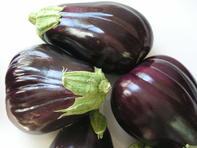
Crop Rotation
Brinjal should be rotated with any non-solanaceous crops such as Brassicas (cabbage and mustard family), Legumes (beans and peas) and Cucurbits (cucumbers and squash) to combat build-up of pests and diseases.Yield (tonnes per hectare)
Conservative: 12 tonnes Average: 20 tonnes Good: 30 tonnes+ Growers that cut back the plants after the earlier harvest in areas that enjoy warm weather into autumn can get a second crop in the year and this can push their production to over 40 tonnes per hectare.Harvesting
Harvesting starts from 10 weeks from planting and can continue for months. Fruit is harvested with knives or sheers. When the fruit is uniformly coloured and skin becomes glossy it is time to start harvesting.
Continual picking promotes fruit set on later flowers and unripe fruit ripens faster. Fruit can be washed in water bathes dried on conveyers and then packed in crates for marketing. Care must be taken to not damage the skin as this promotes postharvest decay.
Storage
Should be stored for a maximum of 14 days at around 10°C at a high relative humidity. Brinjal are highly perishable so should be marketed as quickly as possible after harvest.Pests and Diseases
Major pests: Root-knot Nematodes, Red spider mite, Cutworm, American bollworm, Tip-wilters, leaf-eating beetles, and Aphids.
Major diseases: Bacterial wilt, Verticillium wilt, Powdery mildew, Anthracnose and other fungal leafspot diseases, Tobaco Ring Spot Virus and Botrytis.
For disease and pest control it is advisable to consult your chemical supplier and extension officer for a proper pest and disease crop protection program.
By Louise Brodie